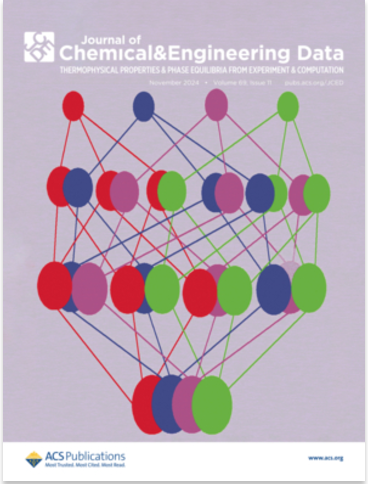复发性卵巢癌患者使用阿特珠单抗联合贝伐单抗和非铂类化疗与安慰剂对比:AGO-OVAR 2.29/ENGOT-ov34 研究的最终总生存期和无进展生存期结果。
IF 2.1
3区 工程技术
Q3 CHEMISTRY, MULTIDISCIPLINARY
Journal of Chemical & Engineering Data
Pub Date : 2024-06-10
DOI:10.1200/jco.2024.42.17_suppl.lba5501
引用次数: 0
摘要
LBA5501 背景:紫杉醇或聚乙二醇脂质体多柔比星(PLD)联合贝伐单抗(bev)是不适合铂类药物的复发性卵巢癌患者的标准治疗方案,但反应通常很短暂。最近,两项试验(ATALANTE,Kurtz JE 等人,J Clin Oncol & NRG GY009,O'Cearbhaill 等人,IGCS 2023)报告称,在复发性卵巢癌患者化疗加贝伐单抗治疗的基础上加用阿特珠单抗(atezolizumab,atezo)有一定数量的优势,但并不显著。AGO-OVAR 2.29研究了阿替佐联合贝伐和非铂类化疗的疗效。研究方法AGO-OVAR 2.29 是一项随机、双盲、III 期试验,评估阿替佐联合贝伐和化疗对复发性卵巢癌患者(pts)的疗效和安全性。符合条件的患者必须在完成铂类化疗后 6 个月内第 1 次/第 2 次复发,或第 3 次复发,无论无治疗间隔时间长短。随机分组前必须进行新鲜活检,以进行中央 PD-L1 检测(VENTANA SP142 检测法)。所有患者均接受每周一次的紫杉醇或PLD和贝伐治疗,直至疾病进展或出现不可耐受的毒性反应,然后按1:1比例随机分配至阿特珠单抗840毫克(q14天)或安慰剂,直至疾病进展或最长疗程为24个月。既往线数、计划化疗、既往贝伐和PD-L1状态是分层因素。意向治疗(ITT)人群的总生存期(OS)和无进展生存期(PFS)是主要终点,两者都将在观察到391例死亡后进行分析。数据截止日期(DCO)为 2024 年 1 月 26 日。OS和PFS分析基于多重Cox回归,并将治疗臂和分层因素作为协变量。安全性报告针对至少接受过一次研究治疗的患者。研究结果574名患者被随机分配到阿特佐(285人)或安慰剂(289人)治疗。45.1%的患者接受了PLD治疗,53.7%的患者接受了紫杉醇治疗。7名患者未开始接受研究治疗。36.1%的患者之前接受过3次治疗,72.5%的患者之前接受过Bev治疗。25.8%的患者PD-L1阳性。在DCO期间,共发生了418例OS和505例PFS事件。阿替佐治疗组的中位OS为14.3个月,安慰剂治疗组为13.0个月(HR为0.83,95% CI为0.68-1.01;P=0.06);阿替佐治疗组的PFS为6.3个月,安慰剂治疗组为6.6个月(HR为0.88,95% CI为0.73-1.05;P=0.15)。PD-L1阳性和阴性患者的HR相似。共报告了580例SAE和141例AESI。71.5%的阿特佐患者和68.9%的安慰剂患者发生了≥3级的AEs。63.7%的阿特佐患者和51.4%的安慰剂患者出现了严重的不良反应。结论对于不适合使用铂类药物的复发性卵巢癌患者,在化疗加贝伐的基础上加用阿替佐并不能明显改善其OS或PFS。安全性在预期范围内。转化研究正在进行中。临床试验信息:NCT03353831 。本文章由计算机程序翻译,如有差异,请以英文原文为准。
Atezolizumab versus placebo in combination with bevacizumab and non-platinum-based chemotherapy in recurrent ovarian cancer: Final overall and progression-free survival results from the AGO-OVAR 2.29/ENGOT-ov34 study.
LBA5501 Background: Paclitaxel or pegylated liposomal doxorubicin (PLD) in combination with bevacizumab (bev) are standard treatment options in patients with relapsed ovarian cancer not candidates for platinum, but responses are usually short-lived. Recently, two trials have reported a numerical but non-significant advantage from the addition of atezolizumab (atezo) to chemo plus bev in the recurrent setting (ATALANTE, Kurtz JE et al., J Clin Oncol & NRG GY009, O'Cearbhaill et al, IGCS 2023). AGO-OVAR 2.29 investigated the efficacy of atezo in combination with bev and non-platinum-based chemo. Methods: AGO-OVAR 2.29 is a randomized, double blind, phase III trial evaluating the efficacy and safety of atezo plus bev and chemo in patients (pts) with recurrent ovarian cancer. Eligible patients had a 1st/2nd relapse within 6 months after completing platinum-based chemo or a 3rd relapse regardless of treatment-free interval. A fresh biopsy for central PD-L1 testing (VENTANA SP142 assay) prior to randomization was mandatory. All pts received weekly paclitaxel or PLD and bev until disease progression or intolerable toxicity and were randomized 1:1 to either atezolizumab 840 mg q14 days or placebo until progression or for a maximum duration of 24 months. Number of prior lines, planned chemo, prior bev and PD-L1 status served as stratification factors. Overall survival (OS) and progression-free survival (PFS) in the intention to treat (ITT) population were primary endpoints, both to be analyzed after observation of 391 deaths. Data cut-off (DCO) occurred on 26/01/2024. OS and PFS analysis is based on a multiple Cox regression with treatment arm and stratification factors as covariates. Safety is reported for pts who received at least one dose of study treatment. Results: 574 pts were randomly assigned to atezo (285) or placebo (289). 45.1% received PLD and 53.7% paclitaxel. 7 pts did not start study treatment. 36.1% of pts had received 3 prior lines and 72.5% prior bev. 25.8% were PD-L1 positive. At DCO 418 OS and 505 PFS events have occurred. Median OS was 14.3 months (mos) in the atezo and 13.0 mos in the placebo arm (HR 0.83, 95% CI 0.68-1.01; p=0.06) and PFS 6.3 mos for atezo vs 6.6 mos for placebo arm (HR 0.88, 95% CI 0.73-1.05; p=0.15). Similar HR were observed in PD-L1 positive and negative pts. In total, 580 SAE and 141 AESI were reported. AEs of ≥ grade 3 were reported in 71.5% in the atezo and 68.9% in the placebo arm. 63.7% of pts in the atezo and 51.4% in the placebo arm experienced serious AEs. Conclusions: The addition of atezo to chemo plus bev did not significantly improve OS or PFS in pts. with recurrent ovarian cancer who are no candidates for platinum. Safety was within the expected range. Translational research is ongoing. Clinical trial information: NCT03353831 .
求助全文
通过发布文献求助,成功后即可免费获取论文全文。
去求助
来源期刊

Journal of Chemical & Engineering Data
工程技术-工程:化工
CiteScore
5.20
自引率
19.20%
发文量
324
审稿时长
2.2 months
期刊介绍:
The Journal of Chemical & Engineering Data is a monthly journal devoted to the publication of data obtained from both experiment and computation, which are viewed as complementary. It is the only American Chemical Society journal primarily concerned with articles containing data on the phase behavior and the physical, thermodynamic, and transport properties of well-defined materials, including complex mixtures of known compositions. While environmental and biological samples are of interest, their compositions must be known and reproducible. As a result, adsorption on natural product materials does not generally fit within the scope of Journal of Chemical & Engineering Data.
 求助内容:
求助内容: 应助结果提醒方式:
应助结果提醒方式:


